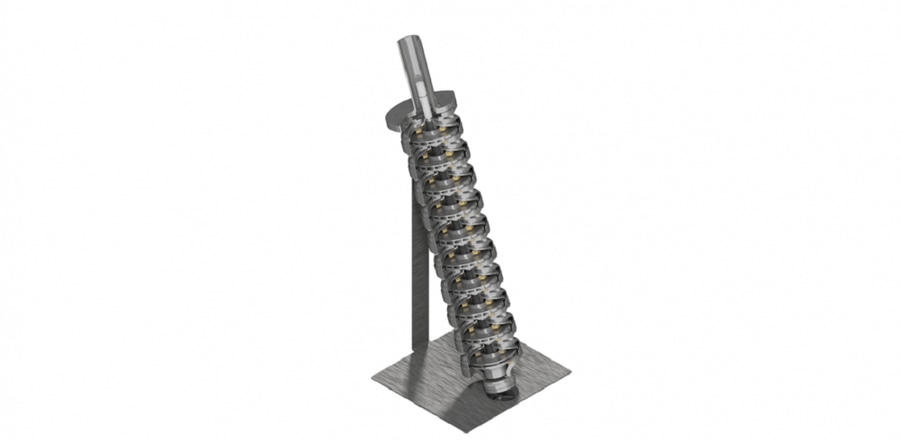
#Product Trends
Quality Management through Vibration Analysis
Vibration Analysis
MarFlex continuously seeks to provide the best product quality. Through rigorous analysis during the design stage of a pump, MarFlex places an emphasis on standardizing the analysis across their products to ensure a consistent level of high-quality products.
During the preproduction phase, MarFlex conducts torsional vibration analysis to verify that the design is structurally sound. MarFlex’s vibration analysis meets industry standards as it has several rounds of preliminary and rigorous analysis on a case-by-case basis depending on whether there are points that need further investigation.
As pumps are used, the forces applied from the rotations result in vibrations when there are external impacts. An example of this external impact can be a result of one side having uneven weight, and the contact resulting from the misbalance can cause vibrations along the entire axel.
The cumulative effect of these torsional vibrations can result in damaged parts through continuous wear. Specifically, it could result in broken shafts, or/and worn bearings. To prevent and minimize the risk of vibrations causing such damage, it is crucial in the preproduction phase to conduct vibration analysis to evaluate the design for machine reliability and safety.
Vibration analysis process
The vibration analysis process contributes to MarFlex pumps by validating its performance to create enduring and high-quality designs. MarFlex analyzes the designs through models such as the lumped parameter model and double checks the calculations. The main analysis, however, is conducted through inspecting the interference points using the Campbell diagram.
All MarFlex pump designs have been analyzed based on the initial set requirements such as the pump’s maximum RPM and torque to plot out the Campbell diagram. The Campbell diagram is drawn by plotting the natural frequencies, the operating speed range for the rotations and the excitation lines. These diagrams are then used to analyze the characteristics of the vibrations within the speed range that the pump operates in. The intersections found on the diagram are used as indicators to identify at what frequency causes the pump to vibrate in a way that could damage the pump.
MarFlex checks for all interference points, and then eliminates them using inspection techniques. This allows MarFlex to focus only on the most relevant points that cause the biggest impact in terms of damaging the pump.
If there are significant interference points that need to be analyzed, a preliminary steady state forced vibration analysis is done after determining the excitation torque magnitudes. Steady state forced vibration analysis is tested under the conditions where the amplitude will approach infinity.
What this means, is that it is tested with an assumption that a pump is ran continuously at a specific hertz frequency. This is done to calculate the vibratory torques and stresses to validate the design and structure of the pump to see if it can handle operating at a specific frequency. Interference points can then be eliminated if the frequency that will cause the pumps to continue to vibrate until destruction, is outside of their operating range.
If significant interference points that damage the system is found in the preliminary steady state forced vibration, it is taken through rigorous steady state forced vibration analysis. The rigorous analysis goes into greater depth into analyzing different components of the system such as loads, drivers, windage, and couplings.
After the steady state forced vibration analysis, preliminary and rigorous transient forced vibration analysis is conducted. For the transient forced vibration analysis, different interference points such as the torque pulsations in the starting process are identified and analyzed. This is because steady state forced vibrations would not be an appropriate method to evaluate certain interference points.
Transient forced vibrations have lower maximum vibratory torques and stresses as it often measures the build up to the steady state values. Furthermore, it is not tested under the assumption that the resonances are infinite. The vibrations that the transient forced vibration analysis evaluate pose a smaller risk since this test is ran under the assumption that the pump will only endure a finite number of induced stresses. Through transient forced vibration analysis, structural adequacy is determined by a different set of criteria, which then further allows MarFlex to eliminate interference points that would not be of concern for the design of the pumps.
However, even with lower torque levels, there can be hammering motions that could potentially lead to gradual wear. If there are still problematic interference points that need to be addressed after analyzing them, MarFlex goes through several methods to eliminate interference points. Some methods MarFlex considers when making improvements to the pump are, altering the natural frequencies, adapting the design to reduce excitation, exploring the option to implement damping, and limiting speed ranges.
After these changes are made, MarFlex runs through the vibration analysis again to see if the modifications have improved the pump design to be more secure and viable for use. MarFlex designers and engineers are passionate about the pumps they design and manufacture. They conduct multiple rounds of comprehensive vibration analysis to verify the quality of the pumps so that it can withstand torsional vibration to run safely and securely.
Trust and Improving propelling MarFlex Quality
The application of vibration analysis embodies the MarFlex values of trust and improvement as it culminates into a high-quality pump. The pump designs are significantly improved as MarFlex employees run several different types and rounds of vibration analysis as they take corrective measures for the pump. As a result, MarFlex pumps have a high standard of reliability and safety.
With high quality operational performance, the frequency of the need for maintenance for MarFlex is minimized. This reliability of the pumps then in turn increases the trust placed in MarFlex pumps amongst our customers. Our values relentlessly drive the motivations of our employees and processes to deliver value to our customers.



